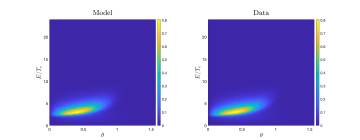
Achievement
We developed a method for reconstructing multidimensional particle distribution functions obtained from Particle-In-Cell (PIC) simulations over a high-dimensional input parameter space. The method generates a data-driven surrogate model that reproduces the input-output relationship of PIC simulations but is dramatically cheaper to compute. We demonstrated the effectiveness of the method by reconstructing the ion energy-angle distribution output of hPIC simulations in two-dimensional and four-dimensional parameter spaces, and we used the surrogate model for sensitivity analysis.
Significance and Impact
The proposed method was applied to the problem of characterizing the energy-angle distributions of the ions impacting on the divertor wall of magnetic fusion reactors, a problem of relevance for the characterization of plasma-surface interactions in nuclear fusion. For this purpose, we employed the hPIC code, an electrostatic PIC code developed to simulate near surface, plasma-material interactions for both magnetized and unmagnetized plasmas. The surrogate model can be used as a cheap alternative to expensive hPIC simulations, at least for parameters inside the convex hull of the training set.
Research Details
In this work, we devised a strategy for construction of a surrogate model for the hPIC ion energy-angle distribution (IEAD) in high-dimensional parameter space, and we demonstrated the approach with up to four physical parameters: electron-to-ion temperature ratio, magnetic field inclination, magnetic field magnitude, and plasma density. The strategy first normalizes the IEAD data via a coordinate transformation in the angle-energy space and employs least-squares fitting and sparse grids to, respectively, deal with noise and overcome sampling challenges in high-dimensional parameter space. A bin-by-bin data fitting procedure over a nonuniform binning of the IEAD was presented. Training and testing data with multiple repetitions was generated, separately, directly from hPIC simulations to inform the surrogate model and assess its predictive capability, respectively.
The surrogate model was used for global sensitivity analysis by computing sensitivity indices (mainly first-order and total-effect). The sensitivity analysis revealed that the electron-to-ion temperature ratio and the magnetic field inclination are the two parameters whose variation most affect the IEAD. In contrast, the results suggested that the IEAD does not appear to be significantly affected by the two other parameters: magnetic field magnitude and plasma density. These results assisted in selecting the two most influential parameters—electron-to-ion temperature ratio and magnetic field inclination—to compute the variation of the moments in this two-dimensional parameter space, identifying different variation modes and regions of influence.
Overall, the proposed approach was shown to provide an effective surrogate modeling tool for fast reconstruction of the IEAD in high-dimensional parameter space and sensitivity analysis.
Overview
We present a data-driven strategy for effective construction of a surrogate model in high-dimensional parameter space for the ion energy-angle distribution (IEAD) output of hPIC simulations of plasma-surface interactions. The methodology is based on a bin-by-bin least-squares fitting of the IEAD in the parameter space. The fitting is performed in a transformed coordinate system to normalize the IEAD, and it employs sparse grids for sampling the parameter space to overcome sampling challenges in high dimensions. The surrogate model is significantly cheaper computationally than direct hPIC simulations yet maintains high fidelity to them, providing a fast emulator for hPIC simulations. Sensitivity analysis based on the surrogate model is utilized to characterize the dependence of the ion impact angle and energy moments on the physical parameters.
To view the publication click here.
Last Updated: June 29, 2022 - 1:50 pm